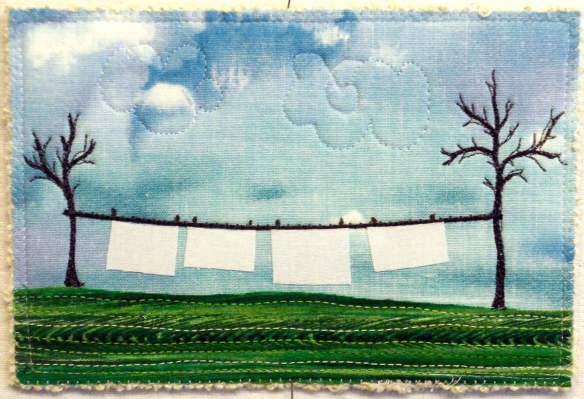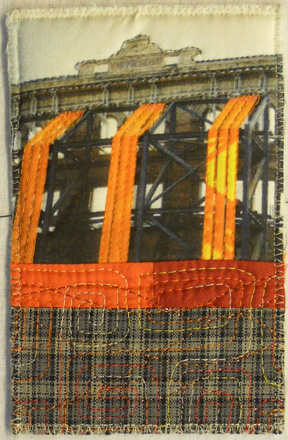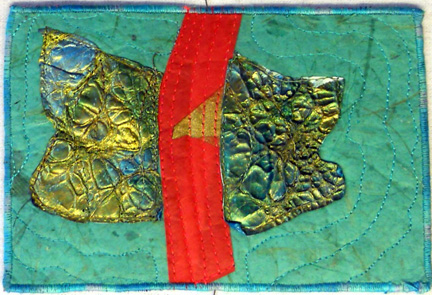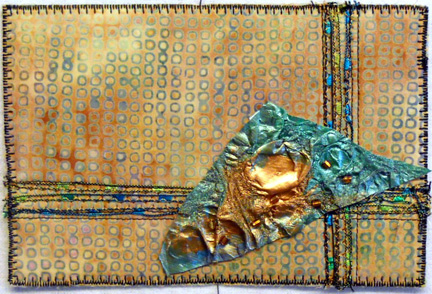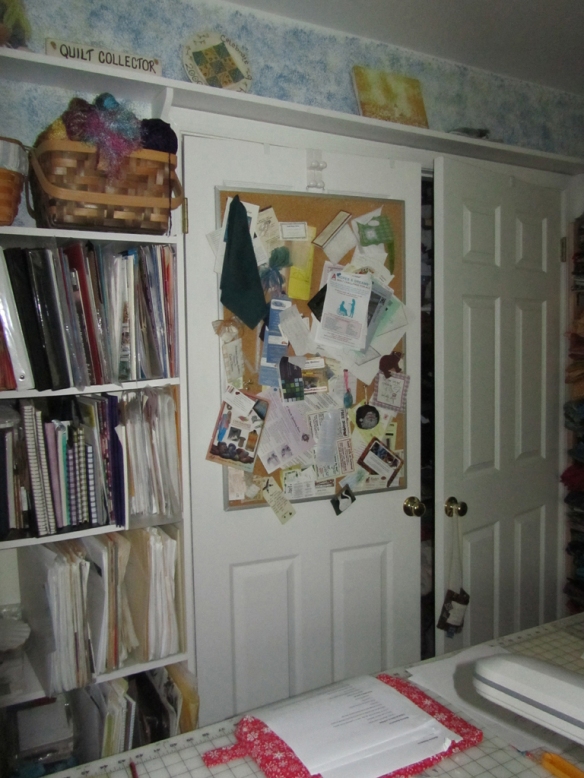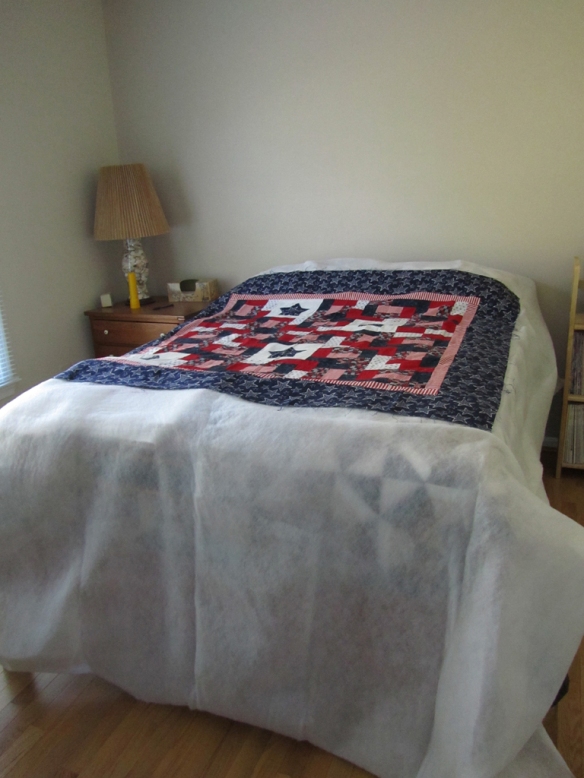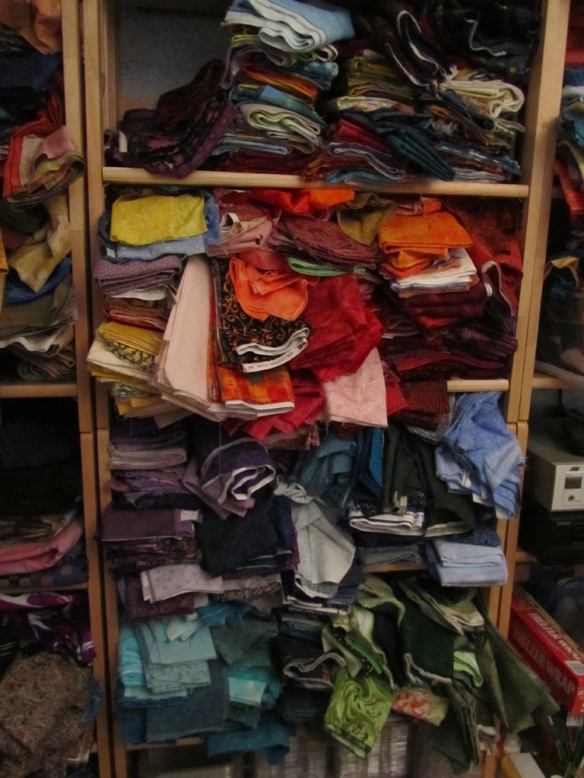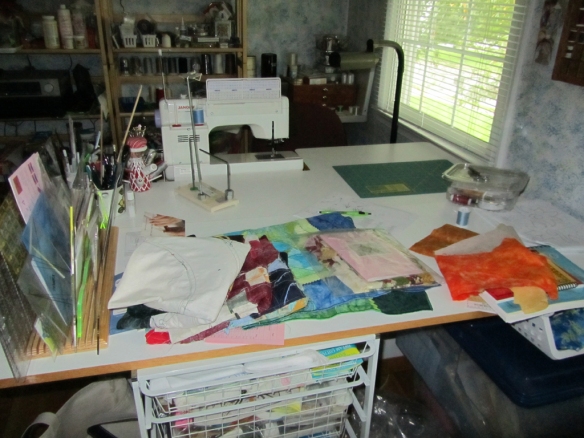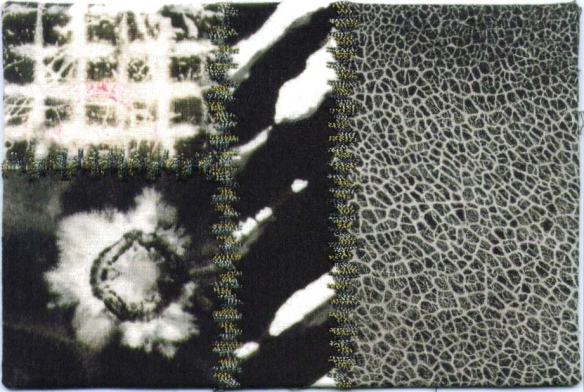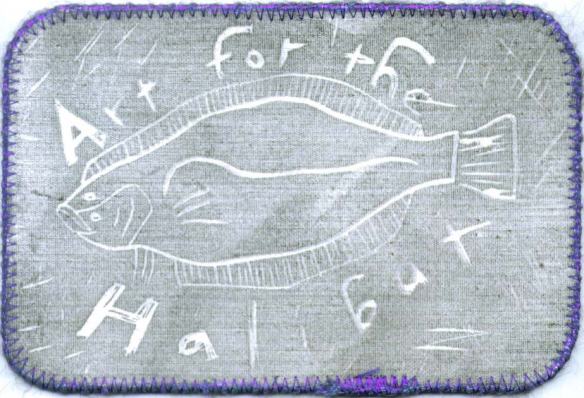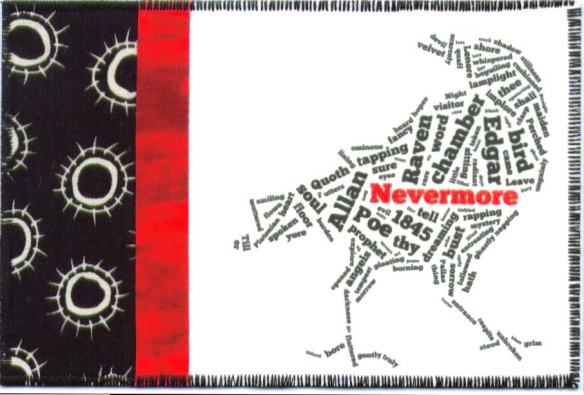One of the trade themes during our last round of trading was “Things You Smell.” I would add that clean sheets hung outdoors to dry are one of my favorite smells!
Monthly Archives: November 2011
Suzanna Bond Lands Viewer’s Choice Award
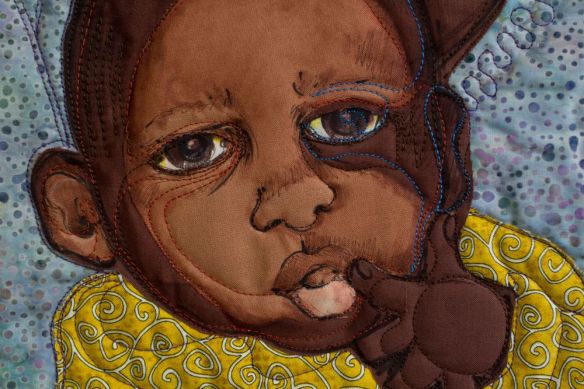 “For me the piece portrays the dignity and beauty of these women in the worst of conditions. She really had that huge bright green wrap on her head. This child is the focus of her life and her whole future,” says Suzanna.
“For me the piece portrays the dignity and beauty of these women in the worst of conditions. She really had that huge bright green wrap on her head. This child is the focus of her life and her whole future,” says Suzanna.The Alphabet: A – F
Our most recent trade of postcards included a category for the Alphabet. Using the first six letters, here is what one group of artists came up with:
Next round will have G – L as a category. I can’t wait to see what we come up with.
Wordless Wednesday – The Persimmons
Wordless Wednesday – Bark
The Palm Challenge – Janet Hartje
Janet Hartje is a member of the Rosie Quilters, formed in 2009 this small group of fiber artists meet monthly at the library coffee shop in Roseville, Minnesota. The library was the most central location for the eight-member group who live in the Twin Cities area. Good friendships and support for a diverse fiber art journey is the primary benefit of the group. Members of the group originally met through Minnesota Contemporary Quilters.
Early in 2011 the group decided upon their first challenge. Each member brought a photograph for consideration, one was selected, a 4-month deadline was set and seven members participated. Janet Hartje read about a call for local artists in Woodbury’s (approximately 16 miles southeast of Roseville) city newsletter. City officials were eager to feature month-long exhibits at Woodbury’s City Hall. Janet took photographs of a few of the completed quilts to show the exhibits curator — the exhibit was scheduled for November on the spot!
Here’s the photograph each member used as their inspiration:
And here are the quilts on exhibit. The artists (from left to right) are Nancy Wick, Zannah Martin, Stephanie Forsyth, Janet Hartje and Janet Hovde.
The artists below are (from left to right) Kathy Tuominen and Melissa Nellis.
 Janet admits, “It’s a little addicting, the high you get from seeing your work hanging in a public space! We would like to find more venues to exhibit our work.” She’ll be scouting out new possibilites and the Rosie Quilters will definitely be challenging themselves again.
Janet admits, “It’s a little addicting, the high you get from seeing your work hanging in a public space! We would like to find more venues to exhibit our work.” She’ll be scouting out new possibilites and the Rosie Quilters will definitely be challenging themselves again.
The quilts are being exhibited for the month of November at Woodbury City Hall. If you’re in the area, be sure to stop by.
Featured Artist- Sherry Boram
Postmark’d Art’s first Featured Artist is Sherry Boram, one of the charter members of the group. Sherry and her husband live in Pendleton, Indiana. The postcards shared here are a few of Sherry’s favorites.
Tell me a little about yourself.
Growing up in a musical family with a house full of instruments, I had to play along even though I mostly wanted to make things! After leaving the nest, there were plenty of opportunities to express my creative side while raising my family, but not until retirement from teaching music and managing the family business was my love of art making fully realized.
You joined in the very beginning in 2004. Why did you join Postmark’d Art?
I discovered nontraditional quiltmaking just before we began our Airstream travel in 1999. A web search brought me to Quiltart.com, and the online discussions occasionally suggested challenge projects. Having had fun and success with some of those challenges, I spotted Franki Kohler’s invitation to join Postmark’d Art, which was the perfect mix of timing, creative fun, travel-friendly size, and community.
How have your postcards changed over the last seven years?
From the beginning, I decided to put my best efforts into these small quilted works – in composition, innovation, and workmanship. I continue with this goal, though some of my postcards are less successful than others! Because fiber postcards lend themselves so well to experimentation, I keep adding new techniques and materials to my repertoire, while continuing to use my tried-and-true favorites. Nontraditional and offbeat materials beckon, so decorator fabrics, silk, and paper often show up in my work. They are also fun to shop for, and I have favorite stores around the country.
It’s been fascinating to watch the evolution of the small art treasures coming from our group, as well as the developing success of their creators on the world art quilt stage.
How do you display your postcards?
I don’t display them. They’re in file boxes, though I take many of them with me when I’m giving a program or teaching a postcard class.
What have been some of your favorite themes?
The early rounds of Postmark’d Art were themeless, but I usually prefer the challenge and focus that a theme provides. One of my favorites is “Obscure Holidays” which we have done a couple of times. Every time I think about some of them, I laugh! Responding to themes with humor or quirkiness is fun for me.
Postmark’d Art has given me the perfect congenial way to exchange art and friendship with people from all over the place and I’m in it for the long haul!
Tell me about your other interests.
Travel, wellness, simplicity, philosophy, vegan cooking, social justice, poetry, current events, family history, equality, women’s social issues, reflexology, energy medicine, First People, peace issues, education reform, human behavior and relationships, community building, spiritualism, environmental hazards related to health, music consumption, crop circles, environmental design, and documentary films. There must be more.
First Friday Studio Tour – Lynn Chinnis
From Wikipedia: “A studio is an artist’s or worker’s workroom . . .”
A friend and I, both mostly traditional quilters, were discussing whether we had studios or sewing rooms. I thought studio was a bit pretentious a term for the kind of quilting I do, but she had heard that if you have more than one machine, it’s a studio. I suspect, therefore, that a lot of us have studios, whether or not we think of ourselves as artists.
And we are eternally curious about other folks’ working spaces. If we visit another fiber artist for the first time, do we even notice the living room? Not unless there is a sewing machine, longarm, loom, spinning wheel, easel, or other piece of equipment set up there. We want to see the workroom.
Today begins our First Friday Studio Tour series where we will peek into our site members’ studios and hear their thoughts on some of the questions I posed to get us started. We’re starting with mine, because someone has to go first.
Do you call it a studio or a sewing room? Why do you think this is so?
Sewing room. I didn’t start out as an artist or a quilter. Originally I made clothing and things for the house. I started with a machine in the corner of our dining area, graduated to the corner of the guest room, and when I finally had a room of my own it was the “sewing room.” It’s probably too late to change an old habit now.
What do you have in the room? Anything that might surprise the rest of us?
Sewing machine, cutting table, shelves of fabric, stabilizers, fusible web, freezer paper, plastic tub of patterns, baskets of ribbon, lace and yarn, buttons, beads, paints, brushes, old plastic egg cartons to use as palettes, stencils, paintstiks, colored pencils, markers, a small bookcase with magazines, catalogs, and file folders of loose patterns and instruction sheets, a bulletin board that is always overcrowded and a design wall that has become a partial bulletin board. Piecing thread; most of the quilting thread is in the basement with the longarm.
Surprising item: a role of hardware cloth, which isn’t cloth at all, but a wire mesh that can be easily cut and manipulated. Used once for a 3-D piece in a challenge.
Do you have anything (supplies, other machines) tucked away in other rooms of the house? How many other rooms?
I have a longarm in the basement, quilting books and magazines in the guest room, more books, mostly quilt history and art, in the living room, spinning wheel and baskets of roving in the dining room, yarn in the bedroom and basement and a small room in the basement with serger, needle felting machine, small sewing machine for taking to classes, dyes and dyeing supplies (buckets, measuring cups, etc.), and my guild’s charity quilt stash. Right now there is a Quilt of Valor top and its batting resting on the guest room bed until I quilt it. My husband does accuse me of taking over the whole house.
How are things organized?
Fabric is mostly by color with lots of exceptions: batiks, orientals, hand dyes, big pieces for backing, anything with so many colors that it can’t be called one color. Scraps are in small boxes by color. Also a big box of fabric that already has fusible web applied, and a separate box of non-cottons: silks, satins, burlap, velvet, etc. Thread is organized by fiber content, and weight. Once or twice a year I take all the fabric off the shelves and sort it. In between times it becomes less organized as I use some and stuff the rest back where I can.
How much horizontal surface do you have and is it ever enough?
Sewing machine in a cabinet, with a drop down back that is always covered. 60″ x 36″ cutting table that is usually covered. If I’m trimming a full sized quilt, I have to move things off the cutting table.
Do you straighten/organize as you go or do you clean up after a project? How many projects do you work on at a time and how do you keep them organized?
This was my cutting table this week. It’s showing aprons for my guild’s booth at the local hospital bazaar, a pile of fabric for a workshop at another guild, fusible web for a batch of postcards, and tiny scraps from another set of postcards. Generally I work on one thing at a time and clean up at the end. If working on more than one project, I try to keep things in separate piles.
Hope you have enjoyed the tour. I enjoyed giving it. Looking through a camera lens always creates a new perspective, and answering my own questions gave me some ideas about how I might be better organized.
Thank you for reading and commenting.
Next month: Heather Lair

